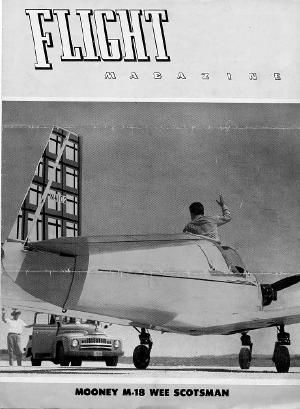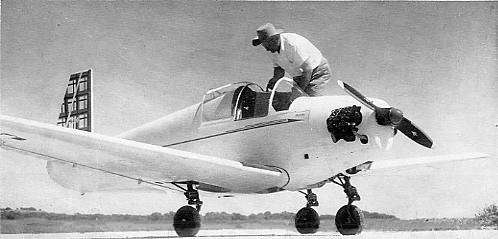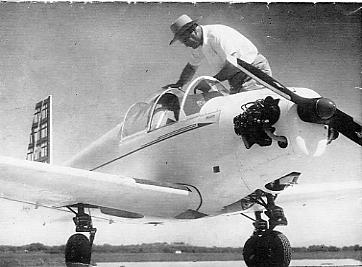 |
Mooney's Wee Scotsman
|
||
|
Plaid paint job on vertical fin identifies
1953version of the Mooney Wee Scotsman. |
|||
|
Wee Scotsman grosses 850 lbs. Empty weight is 520 lbs. with Lycoming engine and 540 lbs. with Continental. Baggage capacity is 75 lbs. Power-off stall speed is 43 mph., cruising speed is over 125 mph., take-off and landing distance is less than 300 ft., rateof climb is better than 1,000 fpm., and ceiling is over 21,000 ft. |
|||
|
HAVING completed its move to Kerrville, Texas, from Wichita, Kansas, where jet traffic and labor shortages combined to force a transfer of operations, Mooney Aircraft, Inc., has resumed production of its popular single-seater Model 18 and is scheduled to fly its new 4-place Model 20 with laminar-flow wing by June. Resumption of M-18 production was marked by several improvements and innovations in a new 1953 version of the little single-seater. Heretofore known as the "Mooney Mite" because it is the smallest certificated airplane in production, the Model 18 now has a new name, "Wee Scotsman." This monicker seeks to capitalize on the M-18's unmatched operating economy, and an impressive promotional campaign will stress the Scotsman's ability to fly on pennies. Bill Taylor, general manager of Mooney Aircraft, says a backlog of 78 single- seaters will be produced through August I with 20 a month thereafter, as compared with 59 deliveries last year.
Cheaper Than Shoe Leather "A penny a mile will actually cover your costs in gas and oil if
you fly a Wee Scotsman," says Al Mooney, the manufacturer. "You can figure it
out for yourself. Fuel consumption averages 3 to 4.5 gals. per hour, depending
on whether your engine is a 65 Lycoming or 65 Continental. This is 90 cents to
about $1.20 per hour. Optimum cruising speed varies from 125 to 138 mph. So it
comes out at about a penny per mile." No full-size American-built auto can match
such economy. Not even shoe leather is cheaper, says Al. This miserly quality of the M-18 Wee Scotsman has prompted Mooney to add another touch of merchandising for 1933 - a plaid color job for the vertical fin on the airplane. This is applied with the use of Scotchlite reflective material, and therein Mooney becomes a pioneer-the first aircraft manufacturer to reflectorize an airplane so that it will glow from reflected light. Reflectorized Tail Fin Just how much of a safety factor this will be is unknown. Being a
single-engine airplane, the Wee Scotsman won't see much flying at night except
when pilots complete their trips briefly after sundown. But it will certainly
flash in a setting sun or in poor visibility. Also, it will flash a warning to
taxiing aircraft when it is parked at night on busy airports. Highlighting improvements in the 1953 Wee Scotsman are the
following:
Controllable Prop Available Coincident with announcement of the new model, Mooney has released information that a new Flottorp controllable-pitch propeller is now available. It is priced at $189 and is expected to prove popular among Wee Scotsman operators. Mooney expects 1953 sales to more than double those of 1952. Fifty-nine of the single-seaters were delivered last year. This year, the plant at Kerrville, Texas, is scheduled to produce 78 Wee Scotsmen through August 1, after which production will be maintained at 1 per working day, or about 20 airplanes per month. By that time, Mooney expects to be in production on his new 4-place, which is scheduled to make its first flight by June. The prototype airplane at present is practically completed, awaiting Al's return to the shop. He has been confined to bed in a body cast as a result of a: broken leg suffered when he fell on the slippery floor at National Airport terminal in Washington. Al was hoping to be back on his feet by the end of April. Weights in actual construction are running almost exactly pound for pound with engineering estimates, and the designer expects to hit the mark originally set without the usual gain in weight. No price has yet been placed on the Model 20, which was designed to cruise at 160 mph. or better. It is being equipped with a 145-hp. Continental engine. Landing gear will be tricycle of the same hand-retracted type proved practical on the single-seater Wee Scotsman. A similar tail design is also used. But the wing will be the first on a commercial light-plane to have a laminar-flow airfoil section, utilizing this to greatly reduce drag and thereby achieve high performance with a minimum of power. Bill Taylor, recently promoted to the position of general manager of the company, said the firm now has 19 domestic distributors and 6 foreign distributors. Exports are running considerably above those of last year. Bill reported, with a large backlog of orders on hand for Latin America, where market exploitation has been intensified. |
|||
|
|
|||

I'm the 'WEE SCOTSMAN'MOONEY Model Eighteen for 1953! |
|||
|
"I'll make your pennies go further, for
I'll take you farther for your pennies. I'll take you a FULL MILE for every
penny you spend for gas and oil.
"And for 1953 all of us 'Wee Scotsmen' are better than ever.We're finished with 'Tex-hyde' flame-resistant plastic butyrate, we have25% more range with our new 16-gallon main fuel tank, we're more ruggedand smoother handling with new tail attachment bearings and nose gearbushings, we're more convenient with a glove compartment designed totake an optional radio installation, and a peephole for convenience inlocking the gear down. "We're MOONEY for '53, and we live up to our new name 'WeeScotsman' by giving you greater economy than any other form of personaltransportation." |
|||
MOONEY AIRCRAFT, INC. |
|||
|
MUNICIPAL AIRPORT KERRVILLE, TEXAS
|
|||
Provided to the Mite Site by Dick Rank, N125M
25 November, 2000



